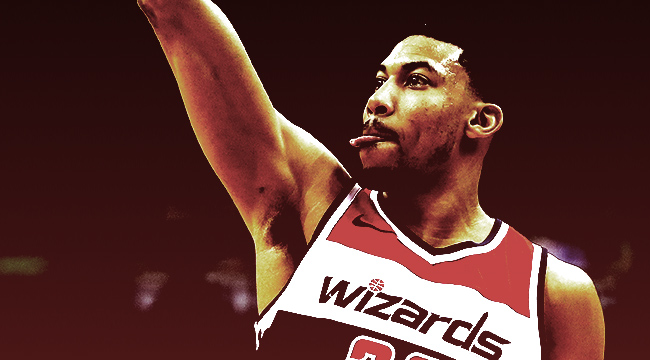
The Washington Wizards were staring down the barrel of The Otto Porter Problem as he entered free agency in 2017. An immensely talented shooter for the final two seasons of his four-year rookie scale contract, Porter brought very little else to the table. He was a passable defender for his position, but commanded a maximum salary, anyway, because of the scarcity of that position.
His playmaking wasn’t fantastic, either, though the Wizards never really asked him to do much with the ball in his hands given that they had John Wall and Bradley Beal playing with him on the perimeter. He wasn’t really capable of creating his own shot, though, nor was he a post-up threat in the least. Basically, he took the “three-and-D” label to the absolute extreme: He was an elite three-point shooter offensively and backed that up with passable enough defense to play his way into a max contract offer from the Brooklyn Nets, which the Wizards matched.
In a league that’s moving further towards each team being a homogeneous group of 6’4 to 6’10 wings and forwards who can do everything on a basketball floor, the incredibly specific talents of Porter left the Wizards with something to be desired from their wing pairing. Overlap of skills between two wing players is important — teams prefer that their wing players include at least one high-level three-point shooter, at least one high-level secondary playmaker, and at least one high-level wing stopper.

Beal and Porter have everything covered on the offensive side of things, with both players able to knock down an elite percentage from beyond the arc. Beal’s also emerged as the secondary playmaker to pair with Wall’s masterful command of the primary role. The other side of the ball wasn’t as successful, as the Wizards ranked just about average defensively over the two years preceding Porter’s gigantic new contract when those two manned the wing positions. Porter was consistently either not quick enough or not strong enough to hang with top-tier wings, which became even clearer in the postseason.
Whether Porter individually took a step forward defensively in 2017-18 is up for debate. Defense, as much as anything in sports, is the ultimate team activity, and it’s often difficult to ascertain whether a team-wide improvement in similar circumstances year over year can be attributed to a specific player, more team cohesion, or a modified scheme. Whatever happened (and it was likely a mixture of all of these things), the Wizards improved significantly when Beal and Porter held down their spots on the wing; their 105.5 defensive rating would rank the Wizards in the top-five league-wide over the course of a full season.
A two-point improvement in defensive rating — the pairing posted a 107.9 defensive rating the year prior — may not seem like much, but that’s the difference between a league-average unit and the elite tier consisting of Boston, Utah, Philadelphia, and San Antonio. Porter boosted some of his individual defensive numbers last season — posting career-bests in steal rate, foul rate, and defensive rebound percentage — although his Synergy numbers paint a bleaker picture. An overall evaluation is somewhere in between, showing a player who plays well in a team system but has some issues when called upon to be a stopper. That said, some more advanced looks at Porter’s perimeter defense in 2017-18 graded him out quite favorably.
https://twitter.com/jgsiegel/status/1039696279943577601
While it’s questionable as to whether he made a marked improvement on the defensive end, Porter expanded his offensive game to legitimately become one of the best non-superstars on that end of the floor. In addition to leading all forwards in above-the-break three-point shooting, he flashed more playmaking and self-creation with the ball in his hands, especially while Wall was sidelined through injury.
He more than doubled his pick-and-roll usage over 2016-17 and, much like everything else he does offensively, was immensely efficient in that area. Porter ranked in the 84th percentile among all players in overall pick-and-roll efficiency and was even better when he took the shot himself, scoring better than 93 percent of his peers in the game’s most common action. He was more comfortable off the bounce in the pick-and-roll, which gives more variety to the Wizards’ offense and allows them to pointedly attack any potential mismatches.
As for his ability as a playmaker, he still leaves a fair amount to be desired, especially compared to his more capable teammates. However, he’s able to fill his role as a tertiary creator well — Porter drives past closeouts, finds teammates on drives, and even runs the occasional pick-and-roll.
Porter was more active off the ball last season as well, making more cuts to take advantage of wayward defenders or subtly adjusting his positioning on the wing to find the smallest opening for his jumper. He was already worth his weight in gold offensively due to his shooting, but these additions to his game on both sides of the floor show that Porter isn’t resting on his laurels after receiving his max contract. Instead, he’s actively pursuing ways to improve his game and bring more to the table for the Wizards.






